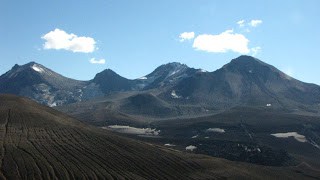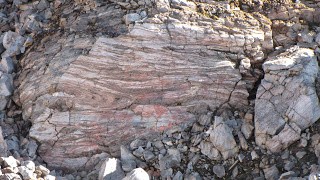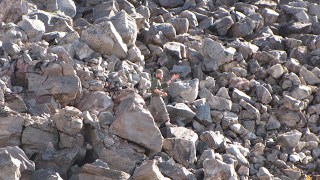Reading over my last blog entry, I noticed something I had written that would make any self-respecting geologist cringe. I will now attempt to correct this glaring discrepancy.
Sitting there nestled below the peaks of Trident volcano and Falling Mountain with Mt. Mageik off in the distance was Novarupta itself, steam curls rising from the center of its plug of dark rhyolite lava.

Novarupta (lower right)
Well, the plug certainly looks dark from a distance but it most definitely appears lighter up close.

Rhyolite boulder – note banding
Rhyolite, the extrusive igneous rock of which the Novarupta plug is composed, is really light in color due to its high silica content.
In the grander scheme of all things igneous, we have two types of rock: extrusive (aka volcanic) and intrusive (aka plutonic). Extrusive rocks are extruded from depth and cool above ground and generally cool so rapidly that little if any crystal formation occurs (a familiar example is obsidian). Intrusive rocks cool underground and have PLENTY of time, up to millions of years, to cool slowly and so crystal formation has plenty of time to occur (a familiar example is granite). These two types of rocks are then categorized by how much silica they contain. The more silica an extrusive rock contains the more explosive it is – the magma that blew out of Novarupta in June 1912 was some serious rhyolite and was so explosive it blew up to 20 miles into the atmosphere.
Up to 75% silica<——————————->55%(or so)silica
rhyolite (Novarupta) —- andesite/dacite —– basalt (extrusive)
granite ——————— diorite ————— gabbro (intrusive)
Notice here that rhyolite and granite have the same amount of silica in their chemical compositions. Alert readers of this geo-blog may wonder “Then why doesn’t granite explode if it contains the same amount of silica as rhyolite?” It must have to do with the amount of gases that are contained in each rock type and the amount of pressure built up in each due to the presence of these gases. Silica by its very crystal structure is able to contain more gases and so is more explosive. But here is the clincher – the Novarupta dome is still rhyolite yet it had ‘de-gassed” at the end of the eruption and formed the rhyolite lava dome. So perhaps granite has somehow become gas-poor (over those millions of years?) while maintaining its high silica content just as the rhyolite in the Novarupta dome had become gas-poor over a much shorter period of time.

Robert ascending Novarupta

Me at saddle w/ Novarupta in upper left background






